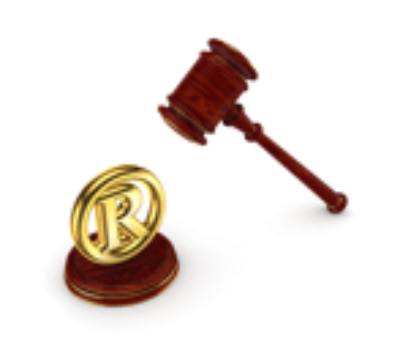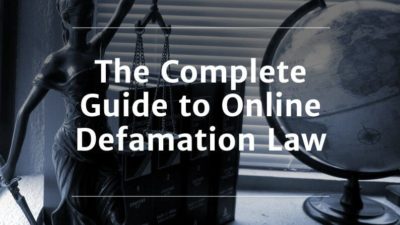
Someone Registered My Name as a Domain Name: What Are My Options?
This page has been peer-reviewed, fact-checked, and edited by qualified attorneys to ensure substantive accuracy and coverage.
Domain names can be a big deal, defining a brand or entire company. Yet someone can register your name as a domain name for as little as $8 to $15 on a “first-come, first-served” basis.
If someone registered you or your business’s name as a domain name, you have three primary options available to acquire the domain:
- Reach out to the cybersquatter or cyberpirate and try to informally resolve the domain name dispute,
- File a lawsuit based on cybersquatting laws to obtain the domain, or
- File a complaint with the World Intellectual Property Organization (WIPO) using the Uniform Domain-Name Dispute-Resolution Policy (UDRP) process.
Below, we examine each of these methods in greater detail and discuss the process of using them. We also address related issues that commonly arise in domain name disputes, such as allegations of trademark infringement.
Before tackling the above, the first step you must take is to confirm that a particular domain name has been registered.
With a team of experienced attorneys, we will fight for the closure you deserve. Take back control today.Don't suffer in silence.
How to Find Out If a Domain Name is Available
Many domain name registrars, such as GoDaddy and Namecheap, allow users to conduct a quick search for specific domain names. This makes it extremely easy to find out if a domain name has already been registered. Those curious can also type a domain name into a search engine or web browser’s address bar.
Registered domain names can take several forms. One form is a domain name that corresponds to a fully functional website and is being used for the website owner’s legitimate business or personal purposes. Another form is a registered domain name that is not actively being used. Rather, it is attached to an empty website with a note stating that the domain name is available for sale.
Sometimes a third party broker is used to facilitate the negotiating process before purchase. Other times you can purchase the domain name directly from the registrar.
How to Reach Out to the Domain Registrant to Purchase the Domain Name You Want
If you learn that a domain using your personal or company’s name has been acquired for an improper purpose, such as to profit from your name or goodwill, your first instinct might be to take legal action. However, it is sometimes cheaper and faster to reach out to the person or website who registered the domain name to see if they are willing to sell the domain name to you.
Submitting an offer to purchase can sometimes be as simple as directly reaching out to the domain name registrant and asking them how much they want for the domain name. Asking the registrant to first provide you with a price quote or range for the domain will ensure that you do not start too high with your bid.
Identify the Domain Name Registrant
Most websites have publicly viewable domain name registration information that can be used to contact the domain name’s owner. If this information is not available, you can search WHOis.net using their Whois lookup tool to find the necessary contact or registrant information.
Oftentimes, domain name owners hide their personal information or register the domain under another name to remain anonymous. Some domain name registrars offer a proxy service that provides anonymity when someone purchases a domain name service package.
When a domain is registered by an individual trying to maintain his or her anonymity, they will typically use a generic contact email address, like 1234respectmyprivacy@WHOISguard.com. This type of email address is usually a working email and can provide an extra layer of privacy for registrants by sending an automated, generic contact form to you after you email that address.
Your emails will still be forwarded to the real person who registered the domain name. This is similar to responding to a Craigslist ad and starting a back and forth email conversation. Both of you will receive the messages at your real email address. However, the other party will only see the anonymized email address.
If a registrant would rather part with a domain name by accepting a reasonable sum of money, nothing further may be needed. After a series of short emails and payment via Venmo, CashApp, or Paypal, the domain name could change ownership. However, it is not always a simple task to identify the domain name registrant.

Filing a Lawsuit to Identify the Domain Name Registrant
One advantage of filing a lawsuit is that you can obtain information you otherwise would not receive through informal channels of communication. Personal information that is normally not disclosed to third-parties, such as a customer’s contact information, can often only be obtained through a lawsuit’s discovery process.
Discovery allows parties to collect information from each other through legal process. Discovery can take many forms, such as under oath depositions of the parties involved, and requests for documents exchanged between the parties.
Third-parties, such as domain name registrars, can also be asked to provide information through the use of a subpoena. A registrar will not release its customer’s information to anyone unless it is compelled to do so through legal process, usually a subpoena in a civil case (for criminal cases, a law enforcement agency may send the domain registrar a warrant).
Issuing a subpoena to a domain registrar through the discovery process of litigation is one of the most reliable methods for identifying a domain name registrant in a civil case involving cybersquatting.
Carefully Weigh the Pros & Cons Before Filing Suit to Identify a Registrant
Filing a lawsuit is a major decision, as litigation can be expensive and does carry some risk, such as making the allegations of the lawsuit. This can present a risk for those concerned with their privacy or who do not want to give the domain name any further publicity.
Second, lawsuits can be expensive and there is no guarantee, even if you win, that you will recover your attorneys’ fees even if that remedy is available.
Lastly, domain names can implicate free-speech rights, and filing a lawsuit is not necessarily a guaranteed method of removing a domain name from the web. Each lawsuit turns on its facts and anyone who pursues litigation must tolerate various levels of risk along these fronts.
As a result, most people do not want to involve themselves in lawsuits concerning domain names unless absolutely necessary.
We dive further into filing a lawsuit to acquire domain names below.
Contact the Domain Name Registrar
After reaching out to the domain owner or registrant, you may not receive a reply. In that case, you may want to contact the registrar and ask them to forward your inquiry to the domain name registrant. Registrars are not required to do this, but they may do it out of courtesy.
Even with anonymity, it is still possible to start a conversation about potential legal issues or sale negotiations concerning a domain. If reaching out is unsuccessful, litigation might be your next option.
Minc Law Tip: Before making an offer to buy a domain name, we recommend that you first speak with an experienced internet attorney. During your attorney consultation, you can explore all legal options and identify the reasonable costs you will incur should you pursue litigation. Having this information will let you know how large of an offer to make when trying to buy a domain name.
What to Do if Your Trademarked Name is Being Violated
If you learn that someone has registered a domain name that uses you or your business’s name, there are several federal laws that you may rely on to recover the domain.
Several of these federal laws govern trademark protections, while others provide protections against cybersquatting, even for those who are not trying to enforce a trademark.
At the federal level, there is the Anti-Cybersquatting Consumer Protection Act (ACPA), which prohibits individuals or businesses from registering domain names in bad faith or for profit. Congress passed the ACPA to combat cybersquatting and it provides cybersquatting protections for trademarks, service marks, and certain individual names.
There is also 15 USC § 8131 (formerly 17 USC § 1129), which focuses more on individuals who are victims of cybersquatting.
Cybersquatting is also addressed at the state level. California and New York have also passed their own cybersquatting laws, which we address below.
Minc Law Fact: There are several different types of cybersquatting. For example, typosquatting involves registering a slightly misspelled version of a commonly used domain name. This type of cybersquatting is often used to commit fraud, such as phishing. The ACPA prohibits typosquatting.
What is Trademark Infringement?
Trademark infringement refers to the unauthorized use of a trademark. But what exactly is a trademark?
A trademark is a word, phrase, symbol, or design (or a combination of these things), that identifies the source of goods or services. In other words, a trademark is an intellectual property right that allows one party to distinguish its goods or services from another party’s.
A popular example of a trademark is a company’s logo. Trademarks can also include celebrity names, as one’s name can function as a symbol or indication of a personal brand.
For trademark holders protected by the ACPA, the element of “bad faith intent to profit” is at the heart of any cybersquatting claim. The ACPA lists the following nine factors to determine whether a domain name was registered in bad faith with intent to profit:
- If the intellectual property or trademark rights of the person is in the domain name;
- If the person’s name is in the domain name;
- If there was any good faith prior use of the domain name in offering any goods or services;
- The person’s bona fide noncommercial or fair use of the mark in a website accessible under the domain name;
- The existence of any intent to divert consumers from the trademark owner’s online location that could harm the mark owner’s goodwill, result in commercial gain, disparage the mark, or create confusion;
- Any attempts by the person to profit from the domain name without first having used (or having an intent to use) the domain name for a bona fide offering of goods or services;
- The existence of any misleading or false contact information when applying for the registration of the domain name, the person’s intentional failure to maintain accurate contact information, or the person’s prior conduct indicating this type of behavior;
- The person’s registration or acquisition of multiple domain names which the person knows are identical, confusingly similar, or are likely to dilute the existing marks of others; and
- The extent to which the mark incorporated in the domain name is distinctive and famous.
Minc Law Practice Tip: The ACPA’s nine-factor list is not exhaustive, and simply acts as guidance for courts when analyzing whether a domain was registered in bad faith with intent to profit. This means the aforementioned nine factors are not hardline rules that must be met, and courts will be afforded plenty of leeway in deciding the rights and responsibilities of the parties, including First Amendment rights such as fair-use for commentary, parody, criticism. To fully understand how these factors will apply to your situation, it is strongly recommended to retain the services of a legal professional who practices in this area of the law.
What Can Filing a Trademark Infringement Lawsuit Do to Help?
If someone is found to have violated someone else’s trademark, there are a variety of legal consequences. The most significant is paying damages for trademark infringement. There is also the ability to recover attorney’s fees incurred when taking legal action.
If bringing suit for trademark infringement in the United States, a plaintiff will most likely rely on remedies available in the ACPA. If a court finds that there was bad faith intent to profit from a domain name, remedies may include:
- Injunctive relief in the form of transferring the domain name,
- Actual damages resulting from any trademark infringement,
- Attorney fees to the prevailing party, and
- Statutory damages ranging from $1,000-$100,000 for each domain name violation.
If taking legal action under 15 USC § 8131, a plaintiff will need to show that:
- The defendant registered “ a domain name that consists of the name of another living person, or a name substantially and confusingly similar thereto,”
- The defendant did not have the plaintiff’s permission, and
- The defendant acted “with the specific intent to profit from such name by selling the domain name for financial gain….”
An exception to liability under 15 USC § 8131 applies to good faith domain name registrations that are intended to be sold along with the lawful use of a copyrighted work of authorship.
Unfortunately, damages under 15 USC § 8131 are generally not available for this type of domain name claim. At most, a party can acquire the domain and recover his or her legal fees.
When bringing an action as an individual, the individual will need to demonstrate an attempt to turn a profit from the selling of the domain name. So just showing that the cybersquatter used the domain name to make money by selling products or services on the website will not be enough to make a case.
Litigation May Be Appropriate When a Registrant Acts With an Ulterior, Non-Monetary Purpose
Some registrants can be greedy or have an ulterior, non-monetary purpose behind registering the domain name. These registrants are not generally receptive to legal demands and do not typically accept monetary offers to sell the domain, no matter how enticing the amount.
Many early cybersquatting cases involved internet “squatters” who simply purchased domain names of big companies and then offered to sell the name to those companies at an enormous profit. However, this often backfired and landed the squatter in hot water, resulting in sizable monetary penalties for some. Thanks to these early cases, this practice is now less common.
Attempts to purchase and then resell domain names for significant profits have significantly declined over the years, but domain name squatting does still occur – now with different motives in mind.
Now, cybersquatting is more likely to be based on a personal grudge, where someone is trying to make another person’s life more difficult. Cybersquatting can sometimes occur between ex-spouses during a divorce or custody dispute. Despite the non-monetary motivations behind cybersquatting, it is still possible to purchase the domain name from an individual acting with malice or ill-will.
But because cybersquatters are motivated mostly by hard feelings, as opposed to the desire to make money, they could have an unreasonable asking price for the domain name, like $1 million. In these instances, it ironically becomes cheaper and easier to resolve the domain name dispute by going to court.
Availability of State Law Claims for Trademark Violations
Some states have also drafted their own cybersquatting laws. For example, California has California Prof. Bus. Code § 17525. This trademark law better protects the victims of cybersquatting for two main reasons.
First, California’s cybersquatting statute does not have an intent-to-profit requirement. Recall that under federal law, the plaintiff must show that the person who registered the domain had the intent to profit at the time of registration.
Proving this intent is straightforward when the cybersquatter reaches out to the victim and asks them to buy the domain name. But most cybersquatters do not do this. Instead, they acquire the domain and wait for the victim to approach them.
When this happens, the plaintiff has trouble proving that the cybersquatter intended to profit from the domain name at the time of registration. Without the cybersquatter reaching out first, there is often no evidence available to meet the intent-to-profit requirement.
Second, California’s cybersquatting law does not distinguish domain name legal disputes involving marks and individual names.
California’s law is similar to the ACPA in that it utilizes the same nine factors in defining bad faith. But it also adds one more factor to cover situations when the domain name is used to deceive voters on election matters. California’s law also provides First Amendment safeguards.
New York has adopted its own cybersquatting law, and it largely cuts and pastes the protections afforded under 15 USC § 8131.
What Are the Costs of Litigating Trademark Infringement Suits?
Litigating a domain name claim can be expensive, but it is an area of the law where courts can award attorney’s fees. These fees will depend on the specific rates of an attorney and the law clerks or paralegals that work on the case.
If a court grants an award of attorney’s fees, this can dramatically reduce the costs to the individual for filing suit. But a word of caution about getting attorney’s fees.
In two separate cases, Bogoni v. Gomez, 847 F.Supp.2d 519, 524 (S.D.N.Y.2012) and Creuzot v. Green, 3:17-CV-404-M-BK (N.D. Tex. Oct. 29, 2019), the plaintiffs spent over $70,000 on legal fees, then asked the court for an award of attorney fees. In both instances, the court granted the request.
However, the court reduced the amount awarded from $70,000 to approximately $44,000-$47,000. Whether the awarded amounts were ever collected is unknown.
Given the high potential costs of suing, it is best to assume that even if you can recover your attorney’s fees, the court may not agree to make the other side pay the exact amount you request.
Furthermore, if you file suit as an individual and not through a trademark or other type of mark, you should consider settlement offers. This is because attorney’s fees are oftentimes the only form of monetary recovery available.
Resolving a Domain Dispute With a Uniform Domain-Name Dispute-Resolution Policy (UDRP) Action
Another common legal action to resolve domain disputes is by filing a UDRP complaint. UDRP stands for Uniform Domain-Name Dispute-Resolution Policy. It is a process established by the Internet Corporation for Assigned Names and Numbers (ICANN) for resolving disputes over internet domain name registrations. A copy of the UDRP can be found at ICANN’s resources page.
The UDRP dispute process is a private arbitration proceeding. It is similar to a lawsuit, but instead of a judge or jury, there is a panel of one or three arbitrators. Other differences include the streamlining of the litigation process, such as less formal rules and procedures concerning discovery and the admissibility of evidence.
A UDRP dispute process starts when notice of the UDRP dispute is sent to the respondent (i.e., the defendant). Almost all domain registrars require domain name registrants to agree to use the UDRP dispute process in their terms of service. But this is only binding on the registrant, not the victim of cybersquatting. In some cases, this can be an advantage for you, especially if the registrant is overseas or beyond the reach of a local court’s jurisdiction.
After the parties are notified and a complaint is filed, the respondent can file a response brief. Then the complainant (who is the equivalent of a plaintiff in a traditional lawsuit) can file a reply brief responding to the registrant’s arguments. After that, a panel hears the arguments from each side.
During the UDRP proceedings, the domain service provider usually locks the domain name. This is to prevent the transfer of the domain name to someone else while the UDRP dispute process takes place.
At the conclusion of the UDRP proceedings, the panel of arbitrators decides whether the domain name violates the UDRP policy. This may result in the awarding of relief, such as transfer of the domain.
Most UDRP disputes are resolved in less than six months. This can be advantageous because it is generally cheaper and faster than traditional litigation. A typical case in the United States can take years to finish if the relief sought is not an immediate injunction or temporary restraining order.
So what is the catch with using in a UDRP proceeding? The biggest disadvantage is that a UDRP proceeding does not work in all domain name disputes. For instance, under federal law, you do not necessarily need a trademark to prevail in a domain name dispute that involves an individual.
In a UDRP dispute, as the plaintiff, you will always need to show:
- You have a trademark,
- The person who registered the domain name lacks any legitimate interest in the mark/domain name, and
- The domain name is being used in bad faith.
The definition of “bad faith” under the UDRP is similar to bad faith under federal law. UDRP bad faith exists when the person who registered the domain name:
- Buys domain name to resell at an inflated profit,
- Prevents the trademark owner/holder from acquiring it,
- Uses it (the domain) to disrupt the business of a competitor, or
- Seeks to financially gain something from the use of the domain name. This can refer to directing web traffic in a manner that is likely to cause confusion about the sponsorship and source of the domain name.
While UDRP proceedings focus mostly on trademarks, individuals (like celebrities) can sometimes use this process if their name is a significant identifier of their goods, service, or brand.
Costs for a UDRP Dispute Proceeding
Fees for the arbitration panel generally range between $1,500 to $4,500, depending on the number of panelists and domain names involved. These fees are in addition to any legal fees paid to the attorneys.
Legal fees will vary, depending not just on the time and effort put into the case, but also on the attorney’s billable rates.
By way of example, Minc Law attorneys charge between $250 and $600 per hour, and our paralegals and law clerks bill $100 to $150 an hour.
You Have Options to Reclaim a Domain Using Your Name
Learning that someone else is trying to extort or harm you or your business’s reputation is a serious problem. Doing so by using your name to register a domain name undoubtedly presents a legal challenge. And the ease in which ill-willed or greedy people can do this is unsettling.
★★★★★
“Absolutely outstanding! Minc Law and Brinton Reston resolved my copyright infringement case, which had been languishing for over five years, in under six months. Superb outcome, lovely people, cannot recommend Brinton or the firm highly enough!”
Sonya, March 15, 2021
If you find yourself or your business the target of a malicious cybersquatter, we recommend reaching out to an experienced internet attorney as soon as possible. An experienced internet attorney can explain the laws and strategies available to acquire or retrieve a domain name and stop cybersquatters from continuing their unlawful behavior.
Minc Law’s attorneys have extensive experience handling cybersquatting matters, especially cases involving the use of an individual’s name, a business name, or a trademark. To learn more about how we can help, please contact us by filling out our online contact form, speaking with a Chat representative, or calling us at 216-373-7706.




